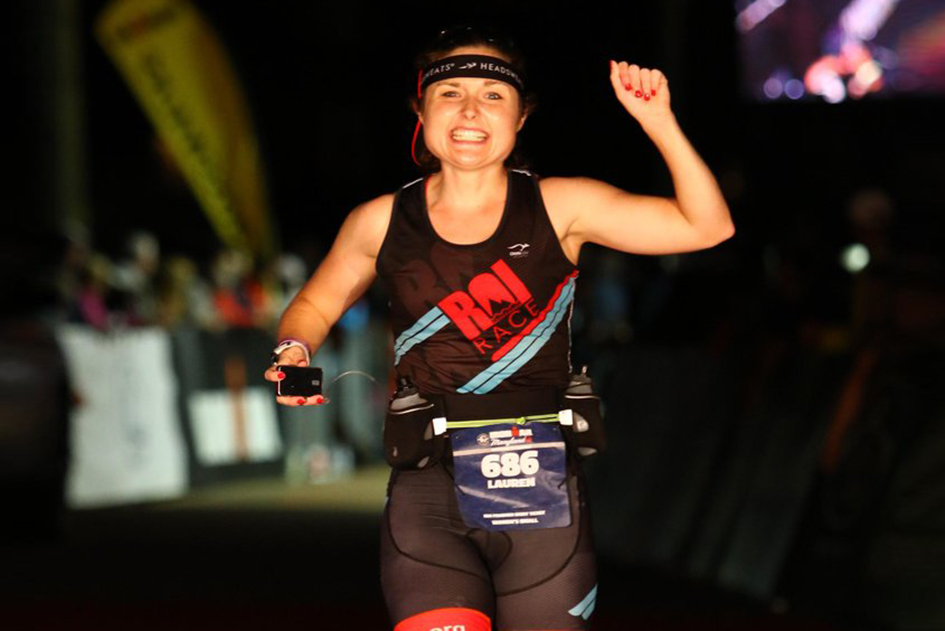
By Shadee Nowrouzi
Completing the Ironman is hard enough as is. Now imagine taking on the challenge with Type 1 diabetes.
Lauren Dahlin, a PhD student in information systems at the University of Maryland’s Robert H. Smith School of Business, completed her first full Ironman triathlon on Sept. 28, 2018, in Cambridge, Md. The race, which consists of a 2.4-mile swim, 112-mile bike ride and 26.2-mile run, is considered one of the most challenging sporting events in the world.
Just last year, Dahlin was diagnosed with severe diabetic ketoacidosis, a complication of diabetes that occurs when the body produces high levels of blood acids called ketones. “I could not walk down the street without feeling winded,” Dahlin says.
She spent five days in the intensive care unit in April 2017, where she received insulin and electrolytes to rebalance her blood acidity. Had she waited much longer to go to the hospital, she was told, she could have gone into a coma.
It was a rough time for Dahlin. She had just been admitted into the PhD program at Maryland Smith. Pursuing a doctorate had been a dream since she was an undergraduate student, and she was adamant about not letting the diagnosis hold her back.
Dahlin learned to manage her blood sugar levels with an insulin pump that delivers insulin through the fatty layer of tissue in her stomach. She is able to monitor her levels throughout the day with a sensor that connects to her insulin pump and phone.
Despite the challenges, Dahlin started training for the Disney Marathon for the Juvenile Diabetes Research Foundation. And in January of 2018, she not only completed the event, but also raised $2,000 for the organization.
“After my diagnosis, I was afraid I would be limited for the rest of my life,” she says. “I thought doing this was the first step to believing I could conquer anything.”
Eight months later, she completed the Ironman. Dahlin faced numerous obstacles throughout the race. After completing the swim, her blood sugar levels were high because of a lack of insulin absorption.
“An hour into the biking, my blood sugar was four times the normal amount despite repeated corrections to my pump,” she says. “I had to do a syringe injection and a site change in a Porta Potty.”
When it came time to do the run, she was overjoyed. Spectators kept commenting on the fact that she had a big smile on her face, to which she finally responded, “Why wouldn’t I be smiling? I’m going to be an Ironman.”
In addition to embracing challenges in her athletic life, Dahlin embraces challenges in her academic life. After working as a research analyst at the Center for Education Policy Research at Harvard University, she became interested in studying the impact of technology on education and society.
As a second year Smith PhD student, Dahlin is focusing her research on how technology has impacted education, diversity and discrimination on online platforms.
She says her diabetes diagnosis has opened her eyes in many ways. “It’s important to cherish the things in your life that are most important to you and not take anything for granted,” she says. For Dahlin, that includes spending time with her husband, family and friends.
Shadee Nowrouzi is a communications writer at the University of Maryland's Robert H. Smith School of Business.
Media Contact
Greg Muraski
Media Relations Manager
301-405-5283
301-892-0973 Mobile
gmuraski@umd.edu
About the University of Maryland's Robert H. Smith School of Business
The Robert H. Smith School of Business is an internationally recognized leader in management education and research. One of 12 colleges and schools at the University of Maryland, College Park, the Smith School offers undergraduate, full-time and flex MBA, executive MBA, online MBA, business master’s, PhD and executive education programs, as well as outreach services to the corporate community. The school offers its degree, custom and certification programs in learning locations in North America and Asia.